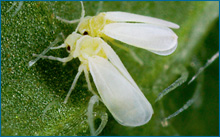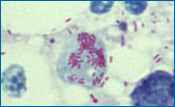原文:Gender-biased bacteria throw off an evolutionary balance

Sweet potato whiteflies
This month, biologists reported that a bacterial infection has run rampant in populations of a major crop pest in the Southwest. The bacterium (called Rickettsia) is a close relative of the species that causes typhus in humans. Its host is the sweet potato whitefly, a tiny bug that can occur in large enough numbers to form visible clouds. Whiteflies suck the sap from plants and spread crop diseases, causing hundreds of millions of dollars of damage in a single season. In just a few years, the percentage of southwestern whiteflies infected with Rickettsia has skyrocketed from 1% to more than 90%. Unfortunately, this is not the boon for local farmers that it might seem. Rickettsia don't sicken the whitefly; instead, the bacterium actively helps the pest spread and increase in numbers. Evolutionary theory accounts for this surprising observation and highlights how we might turn it in our favor.
Where's the evolution?
We are most familiar with bacteria that cause illness; however, a whole host of bacterial species are symbionts and provide benefits to their hosts. The advantage that Rickettsia provides to the whitefly is huge: infected whiteflies produce twice as many offspring as Rickettsia-free whiteflies, and these offspring are much more likely to survive to adulthood than the offspring of uninfected individuals. Why would one species be so benevolent towards another? The answer seems to lie in the evolutionary fitness of the bacterium. In this case, what's good for the host also happens to be good for the resident. Rickettsia are transmitted through the whitefly population from mother to offspring — not, for example, between bugs that alight on the same leaf. In terms of natural selection, this means that any bacterium that happened to have a gene version that benefitted its host's survival and reproduction would be passed on to more new hosts. Through many generations, these genetic variants would become more and more common in the Rickettsia population, and eventually, bacteria that provided bigger and bigger benefits to the host could evolve.
An evolutionary perspective explains another unusual quirk of this interaction: Rickettsia not only improve their hosts' reproductive capacity, they bias it as well — towards having girls. Uninfected whiteflies produce about a 50/50 ratio of female to male offspring, while the offspring of infected whiteflies are around 70% female. In terms of the bacterium's fitness, this manipulation also makes sense. More females means that the whitefly population can increase more rapidly, giving a big boost to the Rickettsia population, and since the bacterium is only passed from mother to offspring (not father to offspring), the bias also generates more possible new infections in the future. It might seem far-fetched for a tiny bacterium to influence its host's reproduction like this, but in fact, nature is full of examples of microorganisms wielding enormous power over their hosts — fungi that cause ants to climb to the top of blades of grass (facilitating the fungus's dispersal), a protozoan that causes rats to lose their fear of cats (allowing the microorganism to spread up the food chain), and many, even more bizarre cases.
Though the human sex ratio is close to 50/50 and our chromosomal system of XX and XY makes that seem natural, sex ratio is not set in stone. Whiteflies produce more females under the influence of Rickettsia, New Zealand parrots produce more males when food is plentiful, and buffalos produce more females during the dry season — to name just a few exceptions to the 50/50 rule. For Rickettsia and the whitefly, biasing reproduction towards females seems to be a win-win situation. Why then, do whiteflies normally produce a 50/50 sex ratio? After all, wouldn't it be advantageous for them to produce more females all the time — even when not infected by Rickettsia? Evolutionary theory explains why most species are comprised of half males and half females — and why exceptions occur.
To understand why a 50/50 sex ratio is so common, consider a hypothetical population of whiteflies, uninfected with Rickettsia, with a 50/50 sex ratio. Imagine that a mutation occurs that causes an individual to produce more female than male offspring. The next generation would have more females than males, and there would be an increase in the gene versions that favor female offspring. Since this generation has excess females, each male has a higher chance of fathering offspring — e.g., each male might father the offspring of 1.5 females on average. At this point, individuals with gene versions that cause them to produce more sons are at an advantage, since sons will likely get to mate more and pass more copies of their genes on to the next generation than daughters will. Now, natural selection will act to increase the frequency of gene versions that favor male offspring — and in the next generation, there would be a corresponding increase in the frequency of males. This cycle can continue indefinitely: whenever females are more common in the population, male-producing gene versions are favored, and whenever males are more common, female-producing gene versions are favored. This is an example of frequency dependent selection, in which the advantage or disadvantage of a particular trait depends on how common that trait is in the population. The result of this see-saw of natural selection is that sex ratios tend to converge on 50/50.
When sex ratios deviate from 50/50, it is for specific reasons. For example, in some organisms (e.g., New Zealand's kakapo parrot), males compete for access to females, and males with particular traits (e.g., large size, strength, large horns, colorful plumage, etc) are likely to mate with several females while other males may not mate at all. This means that if a mother doesn't have the resources she needs to invest in offspring that are likely to have those advantageous male traits, she is better off producing daughters than sons. This situation favors the evolution of gene versions that bias offspring towards female when resources are scarce and towards male when resources are plentiful.
Of course, the southwestern whitefly population now deviates from a 50/50 sex ratio not because of the whitefly's evolution, but because of Rickettsia's evolution. The symbiont has evolved to manipulate its host's sex ratio for its own advantage — setting up an interesting evolutionary conflict. Rickettsia's fitness is maximized by maintaining control of the whitefly sex ratio and biasing it towards females. However, any whitefly that happened to have a genetic variant that would allow it to produce more sons (even while infected with Rickettsia) would have a big advantage! Just as in the see-saw of sex-ratio evolution described above, in a female biased whitefly population, having sons will get a mother or father whitefly more grandkids than having daughters. Because of this, the fitness of individual whiteflies would be maximized by shifting the sex ratio back towards 50/50. The outcome of this evolutionary tug-of-war between the whitefly and its symbiont is still unclear.
Biologists are monitoring the impact this interaction may have on agriculture in the Southwest. While farmers have not yet seen a spike in crop damage, the spreading Rickettsia infection (and the boost it gives its host's reproductive capacity) does seem to have poised the whitefly for a major infestation. However, ongoing research on Rickettsia and its host may yield new strategies to combat pests. Symbionts can exert such a powerful influence over their hosts that scientists have considered using them as an all-natural pest control mechanism. In fact, in 2009, scientists successfully infected mosquitoes with a symbiont strain that halves the lifespan of the mosquito! A better understanding of exactly how Rickettsia affects whitefly fitness and fecundity could help us develop new approaches to controlling the spread of this pest.
Extreme endosymbiosis

Rickettsia A cell infected with Rickettsia
Rickettsia probably sounds like an exotic, unfamiliar strain of bacteria; however, you are closer to this particular bacterium than you might think. More than a billion years ago a close relative of Rickettsia invaded another cell (much as modern Rickettsia took up residence inside the whitefly — a relationship known as endosymbiosis) and wound up staying forever. That cell lineage evolved into the first eukaryotes, and those ancient relatives of Rickettsia evolved into the first mitochondria, the cellular organelles which fuel cells. Eventually, that eukaryote ancestor (and the mitochondria inside it) evolved into all the plant, animals, and fungi alive today — including us! You actually carry the evolutionary cousins of Rickettsia inside every cell of your body in the form of mitochondria.
 转发至微博
转发至微博
0
推荐




 京公网安备 11010502034662号
京公网安备 11010502034662号 